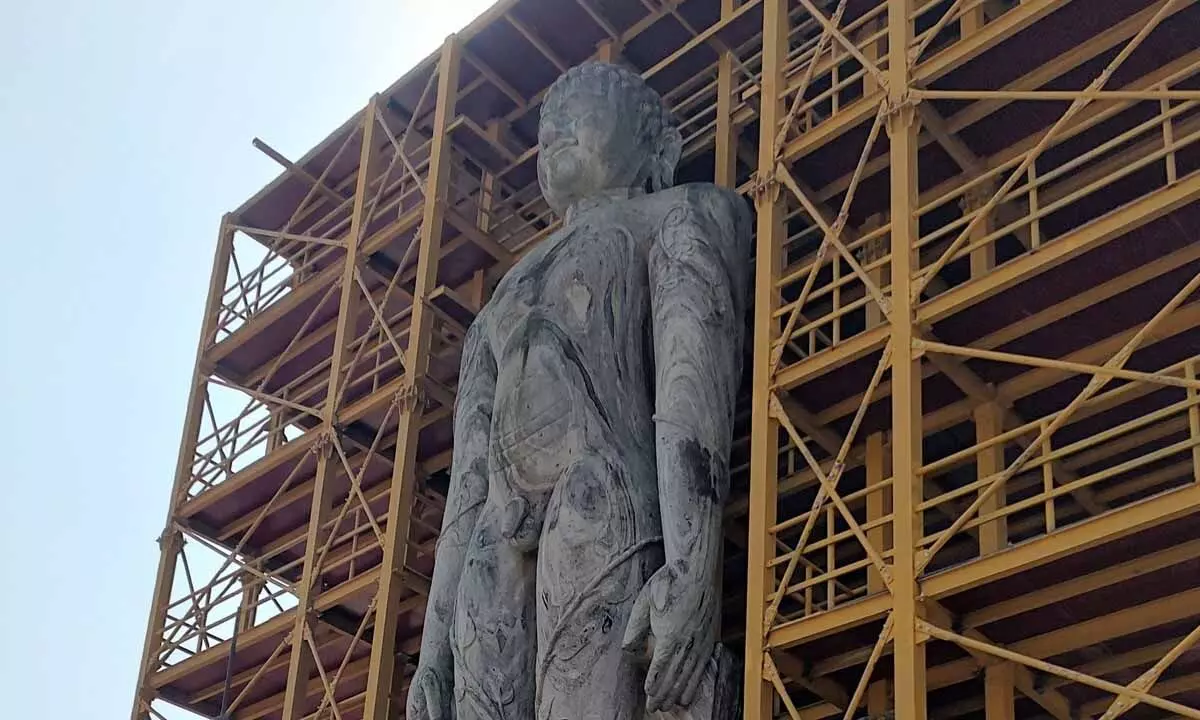Jain temple town wakes up for Mahamastakabhisheka

Lord Bahubali in full glory
Venur: Venur, nestled amidst the majestic Western Ghats and bordered by the serene Phalguni river, is gearing up for the forthcoming Mahamastakabhisheka, slated to commence on February 22. This event marks the third occurrence of the grand ceremony in the 21st century, honouring the Tyaga Murthy (symbol of sacrifice) Bahubali of Venur.
Although Jain scriptures advocate for a Mahamastakabhisheka every 12 years for all Bahubali statues nationwide, Venur, a revered Jain pilgrimage site, has not adhered strictly to this tradition. Since the installation of the Gomata (Bahubali statue) in 1604 by the Jain chieftains of Ajila lineage, Venur has witnessed only two such ceremonies in the 20th century, in 1928 and 1956, thus deviating from the prescribed cycle.
The Gomateshvara Statue in Venur, a towering monolith standing nearly twelve meters tall, is one of Karnataka’s five significant representations of Bahubali. Crafted in 1604 CE under the patronage of Vira Timmaraja, a prominent figure of the Ajila dynasty, this statue is believed to have been sculpted by Amarashilpi Jakanachari, an artisan of historic proportions. Bahubali, also known as Gommata or Gomateshvara, holds a revered position in Karnataka’s cultural and religious heritage, with other monolithic statues adorning pilgrimage sites such as Shravanabelagola, Karkala, Dharmasthala, and Gommatagiri.
The depiction of Bahubali in Venur’s Gomateshvara Statue portrays him in the kayotsarga posture, standing motionless with closed eyes facing westward. Clad in the typical Digambara Jain tradition of nudity, the statue exhibits intricate details, including long ears, curls of hair, and arms extending nearly to the knees, with vines and anthills adorning the limbs.
Central to Bahubali’s iconography is the narrative chronicled in the Adipurana of Pampa, a tenth-century Kannada epic. Bahubali, one of Rishabhadeva’s hundred sons, renounces his kingdom and worldly possessions after defeating his brother Bharata in a series of contests. His year-long meditation in the kayotsarga position, marked by the growth of flora and fauna around him, culminates in his enlightenment or ‘kevala’.
Bahubali’s representation evolved over centuries, with consistent motifs like vines and the presence of attendant female figures. The antiquity of Bahubali gained popularity from the tenth century onwards, with colossal monolithic statues emerging gradually, possibly influenced by public abhishekam rituals.
Despite the waning popularity of Jainism in the Deccan region, the reverence for Bahubali endures, with the Mahamastakabhisheka ceremony held every twelve years at major sites in Karnataka. This ritual, involving the anointment of the statue with sacramental substances, attracts devotees from diverse religious backgrounds. However, Venur has hosted this grand ceremony only four times in the past century, highlighting its significance and rarity.
Venur decks up for the event
This township in the foothills of the Western Ghats, endowed with the perennial river -Phalguni will receive pilgrims from all over the country, mainly from the states of Rajasthan, Gujarat, Madhya Pradesh, Uttar Pradesh, Maharashtra, and Karnataka. All the facilities that are ready to receive the pilgrims are being given a fresh coat of paint, and a few other facilities are being constructed at breakneck speed.
In addition, all the other Basadis of this Jain pilgrimage centre are undergoing developmental work.
The Mahamastakabhisheka is a series of events lasting eight days, from February 22 to March 1. (This is a leap year.) Devotees will pour many substances, including Narikela (tender coconut), Ksheera (milk), Ikshurasa (Sugarcane milk), Kalka Churna (a blend of several herbal powders), Shrigandha (Sandalwood paste), Chandana (red sander paste), and Ashta Gandha( mixture of eight different aromatic pastes). The 32-foot monolithic statue of Bahubali has been bedecked with a steel ‘Attanige’ (Scaffolding right from the feet to the top of the head), facilitating the devotees who offer ‘Abhishekas’ effectively and safely.
The Attanige will be dismantled only after the last devotee has offered his Abhishekas, which is likely to happen in April.















